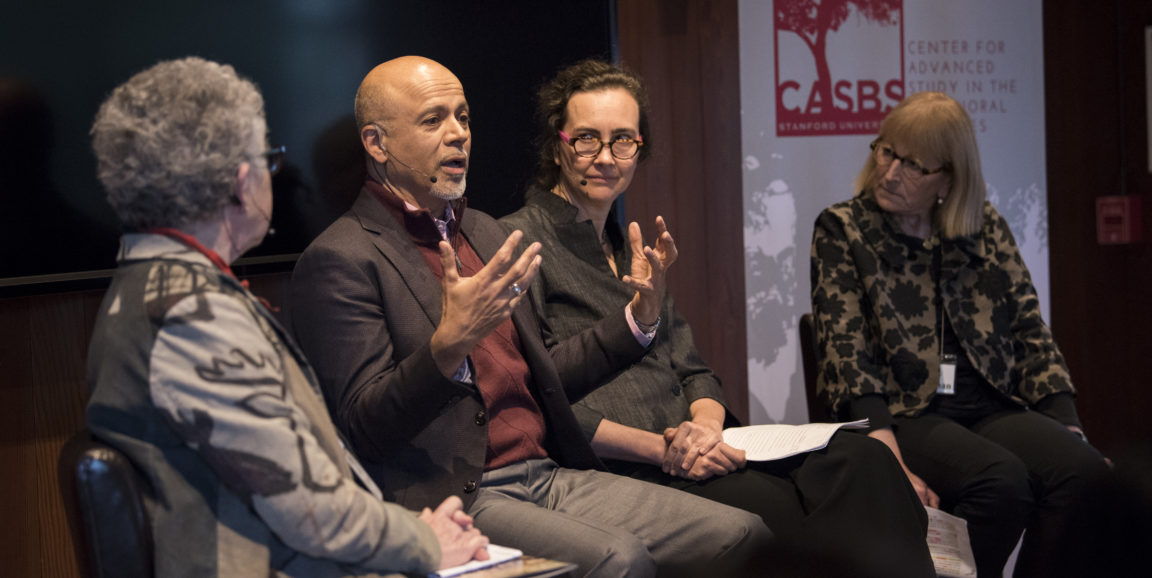How has technology changed the way people interact?
A physician, a linguist and a sociologist tackled these questions and more in a recent panel discussion hosted by the Center for Advanced Study in the Behavioral Sciences and the Catalyst for Collaborative Solutions, both at Stanford.
“Technology is hugely important,” physician-author Abraham Verghese, MD, told the audience. “It’s going to make us better and better – but it’s not going to take away the importance of the human interaction.”
Verghese, whose Presence Center at Stanford focuses on harnessing technology for the human experience in medicine, said the relationship between the physician and patient has been a bedrock of the field for centuries. However, recent technological advancements – particularly electronic medical records – increasingly pull doctors away from face-to-face dealings with their patients.
“We have a medical records system where, for every one hour cumulatively I spend with a patient, I spend two hours charting on this computer and another hour at night further dealing with the inbox related to all of this,” Verghese said.
Some may wonder if the personal touch is still needed, Verghese said. He argued that it is. People can assess a situation in ways that computers cannot, thus avoiding potential medical errors, particularly in the most seriously ill patients, he said. Additionally, the relationship between a doctor and a patient is fundamentally human: an individual providing care to another individual at their most vulnerable.
“The ritual of the exam, when performed well, it really seals the physician-patient relationship,” he said. “It localizes the illness, not on a lab report somewhere, not in an image somewhere, but on one’s body.”
For young adults, technology often substitutes for in-person interaction, but that doesn’t necessarily make the communication less meaningful, said Stanford linguist Sarah Ogilvie, PhD. She spoke of an undergraduate who decided to skip in-person lectures and watch them online at an accelerated speed in order to pay better attention.
“They are forced to concentrate to try and follow what the lecturer is saying and they are no longer distracted by their social media, which they say is the big distraction when they go to a physical lecture,” Ogilvie said.
The words used by the iGen generation – born after 1995 when the World Wide Web became broadly public – provide a window into how technology has shaped their lives, Ogilvie said.
For example, they create different Instagram accounts for different audiences: “Insta” for the public; “Finsta,” an account under a fake name that can only be viewed by close friends; “Ginsta,” for people they know through their gay identity.
Reddit, 4chan and other online forums allow members of iGen to experiment with different personas, Ogilvie said: “They help support an identity that might change. It might change monthly, it might change weekly, or even daily.”
While iGen adapts to technology, older generations seem stuck complaining about the increased time pressures of the digitized world, said Judy Wajcman, PhD, a sociology professor at the London School of Economics who is currently a fellow at the Center for Advanced Study in the Behavioral Sciences.
Perhaps they should blame themselves, she said: “We really value a fast, busy life, an action-packed life, and so we build technologies that feed this speed.”
Despite doomsayers, Wacjman said, her research has shown that cellphones have actually been important for cementing intimacy, and that a similar cycle of “moral panics and messianic hopes” has accompanied most technological advancements, including television.
“If you actually look at what people do with their technologies… people do amazing, different, contradictory things, and will tell you in the same sentence that they love and hate the machines, and they live fine with all these contradictions,” she said.
Photo courtesy of the Center for Advanced Study in the Behavioral Sciences




